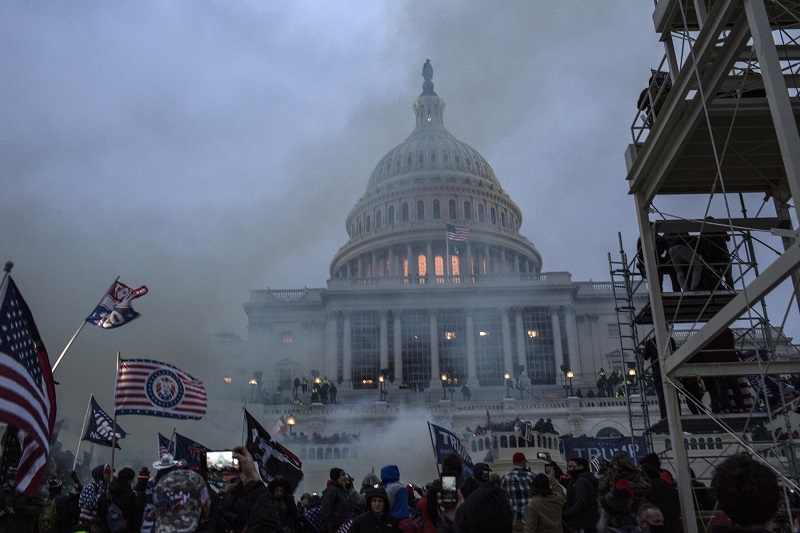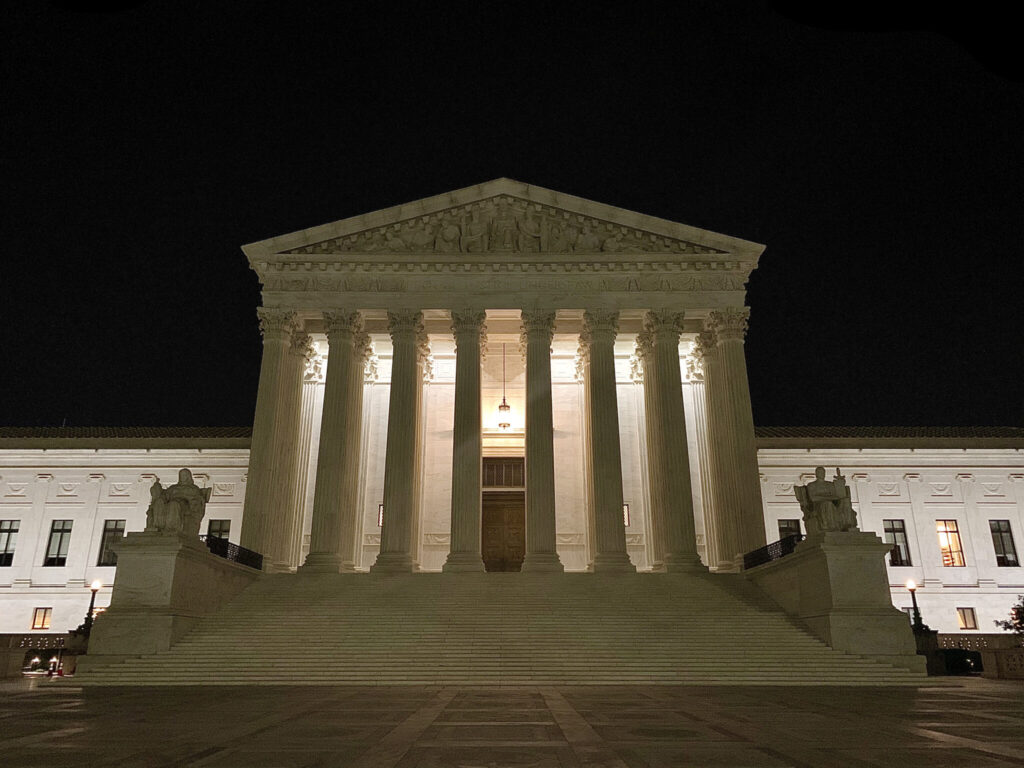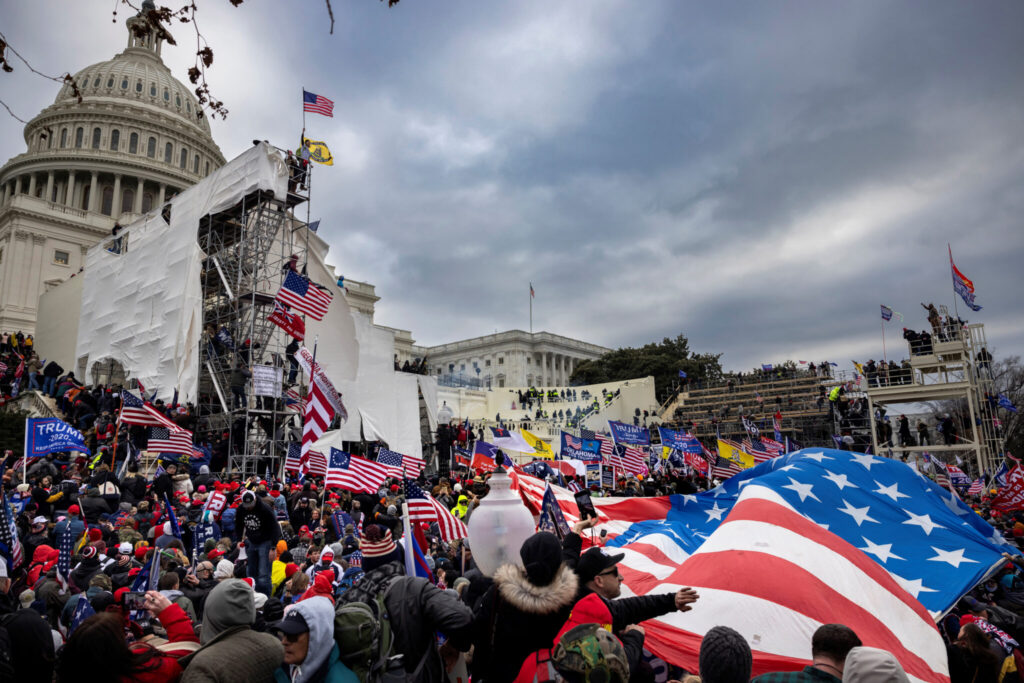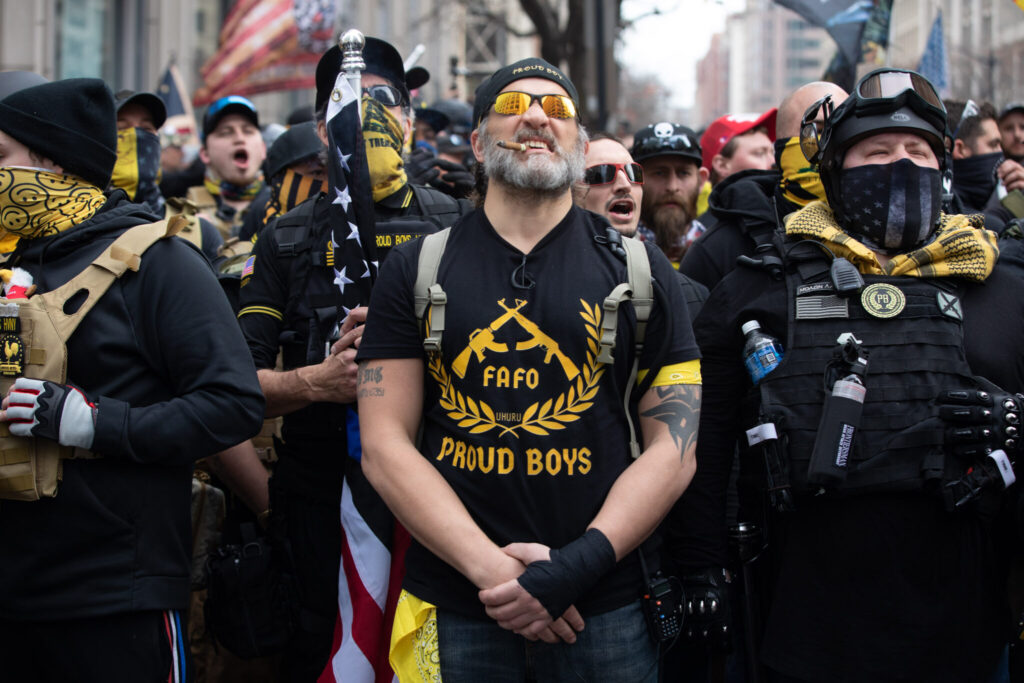Donald Trump: Threatening Courts and Undermining Justice
To download a PDF of the report, click here.
The insurrection at the Capitol on January 6th, 2021, represented an inflection point in Donald Trump’s sustained assault on democratic processes and institutions. It was the culmination of months of lies and fearmongering attacking a number of democratic institutions — from state legislatures to courts and polling places — in an attempt to overturn the 2020 presidential election. Trump is now under criminal indictment in federal court and state court in Georgia for the actions he took in his effort to overturn the election and disrupt the peaceful transfer of power.

Targeting the Capitol on January 6th, rather than other buildings on other dates, was a strategic choice. The congressional certification of the electoral vote was just one of many crucial moments–and Congress just one of many institutions–where Trump attempted to exert pressure in the aftermath of the election. While Trump ultimately chose to focus on Congress’s certification of the electoral vote, various other federal, state, and local institutions were potential targets in the leadup to January 6th. It’s unclear exactly why these attacks did not fully materialize, but the lack of a specific call to action could have played a part. This is in contrast to Trump’s specific call for his followers to come to Washington D.C. on January 6th for a “wild” event at the Capitol. Given the continued incendiary, anti-democratic rhetoric toward government institutions and officials coming from extremist groups and leaders, it is not inconceivable that Trump or a future anti-democratic leader could incite another mob to attack a different government institution.
This report focuses on the threat posed to the courts by the “Stop the Steal” movement. Of course, litigation is a viable and legitimate strategy used by candidates, political parties, and advocacy organizations to ensure that our elections are carried out in accordance with the law. This includes litigation brought by Donald Trump and his campaign during and after the 2020 election. Further, it is not unusual or illegal for people, including public figures on both the progressive and conservative sides of the aisle, to criticize judicial decisions and the judges who make them. It is concerning, however, when that criticism includes veiled or explicit calls to violence. Both prior to and since January 6th, Trump and his supporters have used incendiary and targeted rhetoric to attack federal and state judges, including justices of the Supreme Court.
This report examines three aspects of the “Stop the Steal” movement’s focus on the courts in the weeks, months and years since the 2020 presidential election: first, the “1776 Returns” planning document considered by the Proud Boys, which called on extremists to forcibly seize and occupy the Supreme Court building and other federal buildings in Washington, D.C.; second, threats made against judges as a result of Trump’s and his allies’ inflammatory public comments about the judiciary; and third, the multiple “Stop the Steal” rallies held on the steps of the Supreme Court prior to January 6th, during which speakers used violent rhetoric about the Supreme Court to incite crowds.
“1776 Returns” plan
Perhaps the starkest example of the threat to the Supreme Court in the aftermath of the 2020 presidential election is the “1776 Returns” plan, a detailed planning document that Proud Boys Chairman Enrique Tarrio considered and adopted in part on January 6th. Tarrio and other Proud Boys leaders were later convicted of seditious conspiracy for their actions on January 6th.
“1776 Returns” laid out a plan to “maintain control over a select few, but crucial buildings in the DC area for a set period of time” in order to force a “new election [to be] conducted,” presumably one that would result in Trump’s victory. Along with all six Senate and House office buildings and CNN headquarters, the Supreme Court was one of the buildings targeted by the plan.
The Supreme Court is mentioned by name four times in the nine-page plan:
- First, in a list of “Targeted Buildings”
- Second, in a list of “Man Power Assignments,” seeking a “Lead,” “Second,” “Hypeman,” and “Recruiter” for each location
- Third, as a “Meet Location” in a list of “Patriot Plan Logistics”
- Fourth, if “enough people are around,” as a building to storm, following the signal of a “lead”
The goal of the plan was clear: seize and occupy the Supreme Court and other government buildings to disrupt the peaceful transfer of power and force federal officials to overturn election results.

The plan was initially authored by a South Florida cryptocurrency investor, and Proud Boys leader Enrique Tarrio received a copy of the plan on December 30th. The plan was “significantly edited” while in Tarrio’s hands and the Proud Boys appeared to adopt aspects of it. Federal prosecutors later relied on the plan as evidence in the seditious conspiracy case against Tarrio and other Proud Boys leaders.
Although the Proud Boys did not fully implement the “1776 Returns” plan on January 6th, their serious consideration of it demonstrates the willingness of one of the nation’s largest, most visible far-right extremist groups to consider deploying violence against the Supreme Court to overturn a free and fair election by force.
Threats to judges and justices
In the aftermath of the 2020 election, Trump brought multiple lawsuits, and publicly supported several others, in his efforts to overturn the election. When those lawsuits failed, Trump took to Twitter to attack the courts and judges who ruled against him, publicly framing the judiciary as an essentially corrupt institution conspiring against him in violation of the law and the Constitution–a tactic he had utilized since his days as a candidate, when he attacked Judge Gonzalo Curiel for his Mexican heritage.
For instance, when the Supreme Court in Texas v. Pennsylvania refused to overturn election results in Pennsylvania and other states, Trump accused the Court of perpetrating “a great and disgraceful miscarriage of justice. The people of the United States were cheated, and our Country disgraced.” Trump’s public criticisms of the judiciary were not limited to the Supreme Court. He accused the Pennsylvania Supreme Court of “flagrantly violat[ing] the Constitution,” attacked the swing vote on the Wisconsin Supreme Court for “vot[ing] against me…in a really incorrect ruling” and retweeted a tweet from his son that claimed a Georgia lawsuit was “rigged” against him.

Given Trump’s rhetoric, it is unsurprising that judges who have ruled in Trump-related cases have faced serious threats from the public. In Wisconsin, several members of the state Supreme Court who voted against Trump in election-related lawsuits required extra police protection after threats were made against them. Two of those justices received anti-Semitic threats online, and were the subject of an article in an online neo-Nazi publication. The threats prompted the court’s Chief Justice to issue a statement affirming that “threats of actual or proposed violence have no place in public discourse in a democratic society,” and that “no justice should be threatened or intimidated based on his or her religious beliefs.” The State Bar of Wisconsin issued a similar statement, saying, “A threat to one justice or judge is a threat to all members of the judiciary and carries over to all members of the legal system.”
These threats are consistent with the trend of increased threats and harassment targeted to public officials. The U.S. Marshals, the federal agency dedicated to protecting federal judges, courts, prosecutors, and witnesses, has reported a significant increase in threats over the last few years. Following the January 6th insurrection and threats to courts and judges, the U.S. Marshals also undertook an effort to increase personal and courthouse security for judges and their families, including upgrading home security systems and improving electronic security. While it is unclear what role the “Stop the Steal” movement has played in these increased threats, it seems likely that there is some relationship. For example, judges who are adjudicating cases against January 6th rioters have specifically spoken out about facing threats and harassment over their role in the process.
Put together, these examples and others illustrate a clear pattern of conduct of Trump supporters levying threats against judges whom Trump publicly attacks, when, in reality, they are simply applying the law. Given Trump’s ongoing legal fights, and his continued public criticism of the courts, it is likely that judges presiding over Trump-related cases will continue to face serious threats in the future.
Extremist Rallies at the Courts
For decades, the courts, and the Supreme Court in particular, have been a gathering place for peaceful yet spirited rallies. Although these rallies have historically occurred largely without violence, in the period between the 2020 election and the January 6th attack on the Capitol, Trump and his allies gathered extremist groups at the foot of the Supreme Court to hold three rallies that were notable for their use of violent rhetoric evoking war, revolution, and rebellion, often directed at the Supreme Court. One rally, in fact, took place less than 24 hours prior to January 6th and featured many of the same individuals and groups who participated in the insurrection the next day, including members of the far-right extremist group the Oath Keepers. These rallies, combined with the dozens of lawsuits that Trump brought or promoted, made the courts a primary focus of his allies and supporters.

The January 5th rally at the Supreme Court was similar to the other two major “Stop the Steal” rallies that took place on November 14th and December 12th. All three rallies were organized and attended by many of the same “Stop the Steal” players who participated in the January 6th insurrection, including members of the Oath Keepers and Proud Boys. Although these rallies did not devolve into the type of violence that would unfold on January 6th across the street at the Capitol, they had the potential to, given the heavy presence of far-right extremist groups.
The January 5th rally was co-hosted by Virginia Women for Trump and the American Phoenix Project, a group led by Alan Hostetter and Russel Taylor, and linked to the far-right militant Three Percenter movement. Both Hostetter and Taylor were convicted of criminal conspiracy to obstruct an official proceeding for their activities on January 6th. Several of the speakers at that rally spoke in violent or threatening terms. Ali Alexander, a well-known far-right provocateur, effectively named the Court as a target, proclaiming at the rally that “we are here to stop a coup that’s going on in our country. It’s happening in this building behind me.” The “building behind me” was the Supreme Court. Another speaker, Leigh Taylor Dundas, accused the Supreme Court of “[selling] out the very bedrock of the principles on which they were freaking founded,” and claimed that Texas v. Pennsylvania, a lawsuit brought by Texas Attorney General Ken Paxton (and joined by 17 other states) urging the Supreme Court to overturn election results in several states, “drew a new Mason-Dixon line, a line that…separated the states that still give a damn about the U.S. Constitution from those that don’t.”
Alex Jones and Roger Stone were among the most prominent far-right figures who spoke at the rally. Both spoke of the moment in all-or-nothing terms. Jones urged the crowd to “commit to total resistance,” while Stone, surrounded by armed members of the Oath Keepers, framed the movement as “a fight for the future of the United States of America” and “between good and evil.” While Jones and Stone used implicitly violent rhetoric, Hostetter and Taylor explicitly referenced the use of force. Taylor told the crowd that “we will fight and we will bleed” and “we will not return to our peaceful way of life until this election is made right.” Hostetter simply told the crowd that “we are at war.”

Hostetter and Dundas were joined by several other speakers in making explicitly violent, threatening comments with references to war and battle. Dundas, quoted above, warned that “any alleged American who acted in a turncoat fashion and sold us out and committed treason – we would be well within our rights to take them out back and shoot them or hang them.” Suzanne Monk of D.C. Women for Trump declared that “the war is here. It’s happening now.” Tom Speciale of Vets for Trump promised, “I will be standing along every one of you patriots no matter… how violent it gets if necessary. We will take our country back.” One of the last speakers of the rally, Morton Irvine Smith of the American Phoenix Project, rallied the crowd: “We have been called to battle and battle we must not fear. Without the fight, there can be no victory.”
The November 14th and December 12th rallies featured similar speakers, attendees, and rhetoric to the January 5th rally. The December 12th rally is notable because it occurred the day after the Supreme Court declined to hear Texas v. Pennsylvania, and in the wake of Trump tweeting his disapproval of the Court’s decision nine times over the next two days, riling up his supporters. Together, the three rallies made clear the far right’s animosity towards the judiciary, particularly the Supreme Court, as well as its willingness to use violence to achieve its desired outcome.
Conclusion
As Donald Trump and his allies sought to overturn the results of the 2020 presidential election, they targeted the courts in several ways. Now-convicted seditionists in the Proud Boys contemplated a plan to violently seize and occupy the Supreme Court on January 6th. Trump repeatedly criticized courts and judges, in many instances prompting his supporters to credibly threaten those judges. Trump supporters held three rallies in front of the Supreme Court, including one the day before January 6th, which featured incendiary violent rhetoric, often directed at the Court itself. Although the courts were ultimately not attacked on January 6th, Trump’s sustained anti-democratic rhetoric continues to make federal and state courts potential targets for his supporters. As Trump’s legal battles intensify, and the 2024 presidential election approaches, the threat of violence posed by the far right to the judiciary is one which demands serious attention and vigilance.